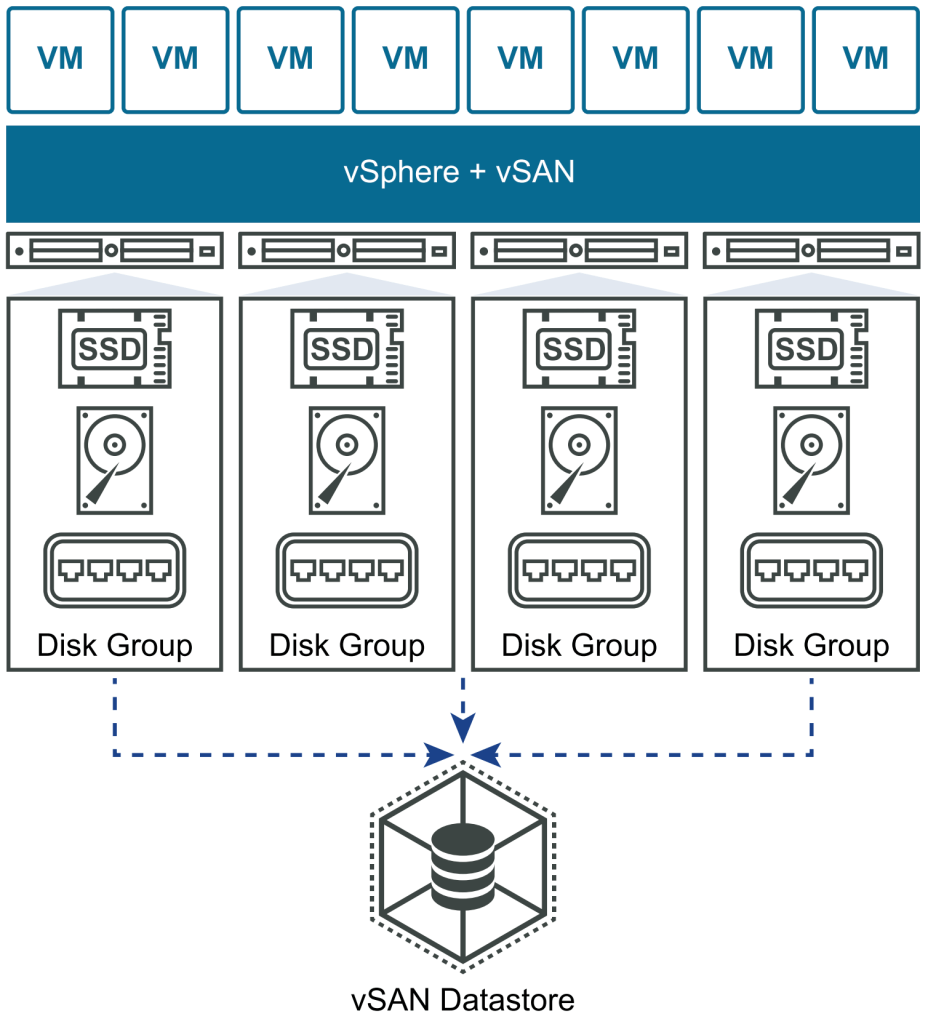7600 GB Disk 544 GB Swap 8144 GB Virtual Machine Raw Capacity Requirements 8144 GB Virtual Machine Raw Capacity Requirements 2 FTT1 RAID1 16288 GB Final Virtual Machine Raw Capacity Requirements 34 GB vSAN Memory Consumption 16288 GB VM Raw Capacity 16322 GB Total Raw. Disk group sizing is an important factor during volume design.

Vmware Vsan Design Guide Vmware
VMware vSAN Storage design includes conceptual design logical design network design cluster and disk group design and policy design.

. This capability adds cost because additional hardware for the disk groups is required. Learn about vSAN disk groups and data storage architecture. Virtual Blocks Understanding Vsan Architecture Disk Groups.
The design uses the default storage policy to achieve redundancy and performance within the cluster. This is a per-disk group basis. How does this occur.
Select all the disks if you are creating the snapshot as an impromptu backup. VSAN Cluster and Disk Group Design for Consolidated SDDC When considering the cluster and disk group design you have to decide on the vSAN datastore size number of ESXi hosts per cluster number of disk groups per ESXi host and the vSAN policy. It states the following.
Vsan aggregates locally attached disks of hosts that are members of a vsphere cluster to create a distributed shared storage solution. As you can imagine a vSAN Disk Group represents a failure domain that needs to be considered. Vsan enables the rapid provisioning of storage within vmware vcenter as part of virtual.
Each disk group contains one flash cache device and one or more capacity devices. VMmark 2x expanded this to multiple servers and platform-level workloads. More stored data from additional VMs will typically increase the aggregate working set size across the hosts in the cluster.
More workloads typically mean more hot data. If the flash buffercaching device fronting a Disk Group fails the corresponding Disk Group will be marked as Degraded and go offline. VSAN can also support up to seven magnetic drives per disk group and up to five disk groups per host or up to 35 drives per node whichever maximum is reached first.
Disk Group Design Considerations With the use of much larger capacity devices the potential of more workloads may put additional strain on the buffering tier. On each ESXi host that contributes its local devices to a vSAN cluster devices are organized into disk groups. Most use cases four hosts are recommended each containing at least one disk group with at least one SSD flash drive and one mechanical drive as illustrated in Figure 1.
The fault domains feature in vSAN is an optional configuration option to improve the resilience of a cluster based on your topology. However if the flash cache device is larger than 600GB the only 600GB of the device is used for caching. Vmware vsan is a hypervisor-converged software-defined storage platform that is fully integrated with vmware vsphere.
Design and Operation Considerations When Using vSAN Fault Domains. The design of DDC in vSAN provides a data path that strives to keep guest VM latency low. This design guide provides guidance and best practices for designing environments that leverage the capabilities of VMware NSX-T.
121 Disk Groups Disk groups by definition are management constructs created by the combination of locally attached flash-based and magnetic disk devices. In the example thus far again no DedupeCompression enabled the following holds true. While vSANs two-tier architecture helps minimize impacts on performance an insufficient hardware configuration or a collection of high-demand workloads may overwhelm the configuration enough to where VMs may see increased latency.
It ensures that data in the cluster remains available in the event of a single host or a group of hosts such as a rack or a data closet are. To create a disk group you define the disk group and individually select devices to include in the disk group. VSAN Datastore Size The size of the vSAN datastore depends on the requirements for the datastore.
Compare the difference between Hybrid and All-Flash solutions and how each affect performance ou. The design of DDC in vSAN provides a data path that strives to keep guest VM latency low. See vSAN Design and Sizing Guide.
The devices used for caching cannot be shared across disk groups and cannot be used for other purposes. When you create a disk group consider the ratio of flash cache to consumed capacity. The ratio depends on the requirements and workload of the cluster.
If more ESXi hosts are available in the cluster more failures are tolerated in the cluster. The creation of a disk group requires the assignment of a single flash-based deviceSAS SATA or PCIe SSDand one or more magnetic disksSAS or SATA HDD. Each disk group must have one flash cache device and one or multiple capacity devices.
In version 60 of Virtual SAN if the flash device used for the caching layer in all-flash configurations is less than 600GB then 100 of the flash device is used for cache. While vSANs two-tier architecture helps minimize impacts on performance an insufficient hardware configuration or a collection of high-demand workloads may overwhelm the configuration enough to where VMs may see increased latency. VSAN Conceptual Design and Logical Design This vSAN design is limited to the management cluster.
More available disk groups can increase the recoverability of vSAN during a failure.

Vsan Disk Groups Mastering Vmware

Vmware Vsan 3 Nodes Mode 4sysops

Vmware Vsan Pay As You Grow Gbm Gulf Business Machines

Mysticmarvin Vsan Best Practices Part Ii Vmware Vsan Best Practices



.png)
0 comments
Post a Comment